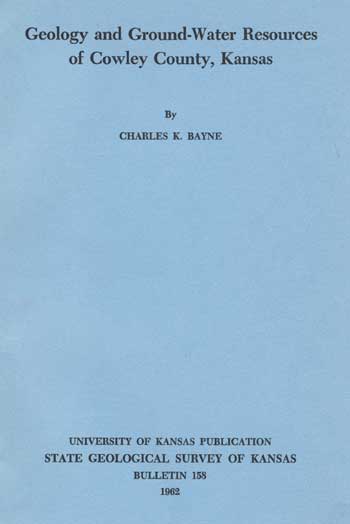Geology and Ground-water Resources of Cowley County, Kansas
By Charles K. Bayne

Originally published in 1962 as Kansas Geological Survey Bulletin 158. This is, in general, the original text as published. The information has not been updated.
You may also wish to visit our web site on the Cowley County geologic map.
Abstract
This report describes the geography, geology, and ground-water resources of Cowley County in south-central Kansas. Cowley County, which has an area of about 1,136 square miles, is in the Osage Plains and the Arkansas River Lowlands sections of the Central Lowland physiographic province and is drained by Arkansas River and its tributaries. Walnut River and Grouse Creek are the principal tributaries to Arkansas River in this area. The climate is characterized by wide variations in temperature and precipitation. The normal mean annual temperature at Winfield is 57.8° F and the mean annual precipitation is 31.27 inches. The population of Cowley County was 37,040 in 1959. Arkansas City, the largest city, had a population of 14,606, and Winfield, the county seat, had 10,848.
Agriculture is one of the principal occupations in the county and wheat is the chief crop. In 1955 the value of field crops was $4,665,000, and the value of beef cattle, $5,100,000. The county is an important producer of oil and gas. Cumulative production of crude oil to the end of 1960 was 106,462,000 barrels. The oil is produced principally from the subsurface strata known to drillers as the "Layton sand," "Bartlesville sand," "Mississippi lime," and "Arbuckle lime," but a total of 15 zones produce oil. Most natural gas is produced from rocks of the Admire and Douglas Groups.
Rocks that underlie the county but do not crop out within it range in age from Precambrian to Late Pennsylvanian, and it is from several zones within these rocks that oil is produced. Rocks that crop out in the area range in age from Late Pennsylvanian to Recent, and it is from these rocks that ground water is obtained. Generally the Upper Pennsylvanian and Permian rocks below the Wreford Limestone are less productive aquifers than the cherty and cavernous limestones above in the Chase Group. Moderate yields of water generally can be obtained from the Wreford and Barneston Limestones. The Fort Riley Member of the Barneston Limestone is also an important source of building stone. Pleistocene deposits, which occur in the principal stream valleys and as terrace deposits in the area west of Walnut River, are the most important source of ground water in the county. The largest yields of ground water are obtained from the Wisconsinan terrace deposits and alluvium in the Arkansas River valley.
Water is obtained from wells as deep as 365 feet, but most wells are less than 100 feet deep. Most wells in the area are drilled wells, but large-diameter dug wells are used in the low-producing limestone aquifers, and driven wells are used in the valley areas. Yields range from a few gallons an hour in the poorer limestone aquifers to 1,000 gpm (gallons per minute) in the Arkansas River valley.
About 6,500 acre-feet per year of ground water is used for public and for small industrial and irrigation supplies. At this rate of withdrawal, the quantity of water in storage in the Pleistocene deposits alone would last about 40 years.
The water from the limestone aquifers is generally a calcium bicarbonate water, but the water from the cavernous limestones of the Lower Permian and from deep wells in other aquifers may contain a strong concentration of sulfate salts. The water from the limestone aquifers generally is hard but usable, except in areas of local pollution.
Water from Kansan and Illinoisan deposits is a calcium bicarbonate type and is hard but otherwise of good quality, except in one small area of pollution in the Illinoisan deposits west of Winfield. Ground water containing excessive chloride and sulfate ions is discharged from Permian shales into Wisconsinan terrace deposits and alluvium in the Arkansas River valley, accounting in part for the poor quality of water in this aquifer, but more serious problems are caused by local pollution from oil-field brines, which in past years were permitted to enter the aquifer. The brines move downgradient in the valley near the base of the aquifer, and several public-supply and domestic wells have been abandoned because of contamination by the brines. Future development of ground-water supplies in the Wisconsinan terrace deposits and alluvium of the Arkansas River valley is likely to be affected by the brines.
The basic field data upon which most of this report is based are given in tables and include records of 202 wells and springs and partial or complete analyses of water from representative wells. Logs of 281 test holes and 4 wells also are given.
Kansas Geological Survey, Geology
Placed on web May 21, 2009; originally published August 1962.
Comments to webadmin@kgs.ku.edu
The URL for this page is http://www.kgs.ku.edu/General/Geology/Cowley/index.html